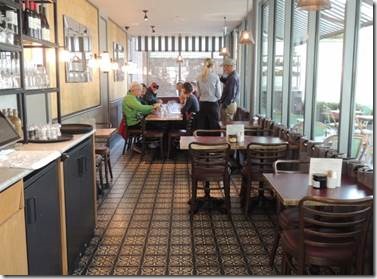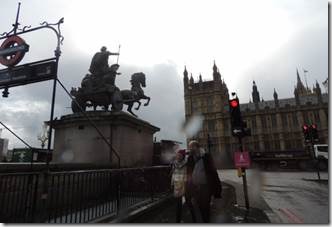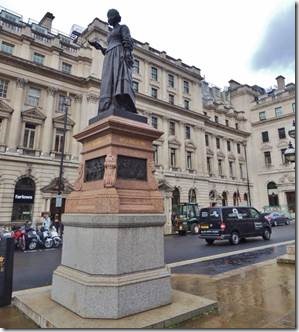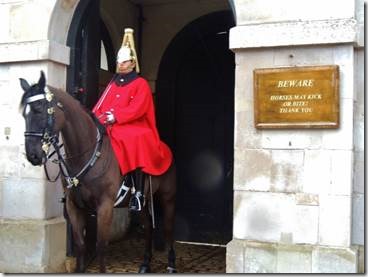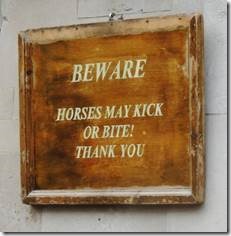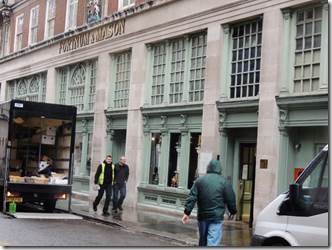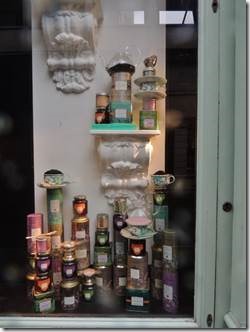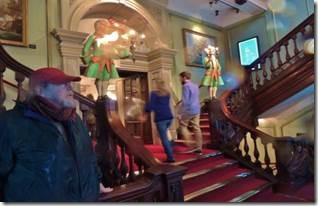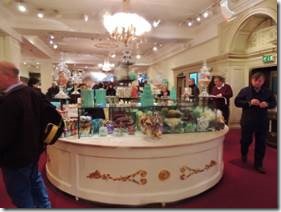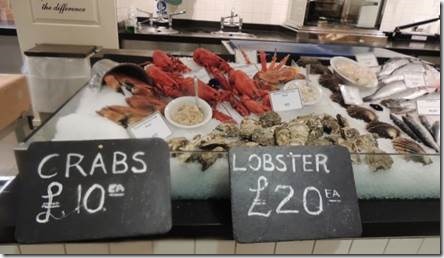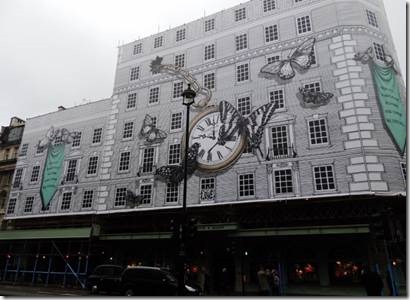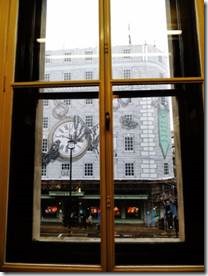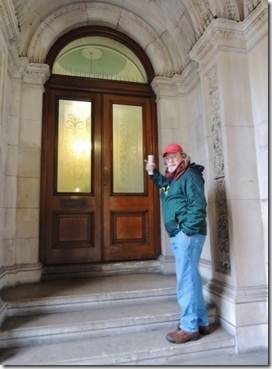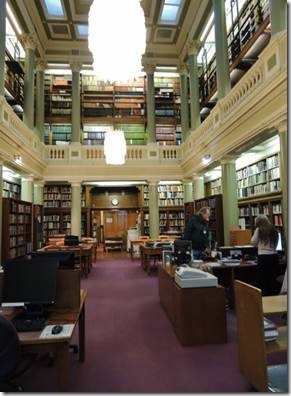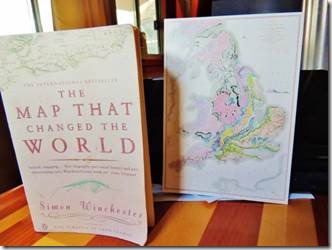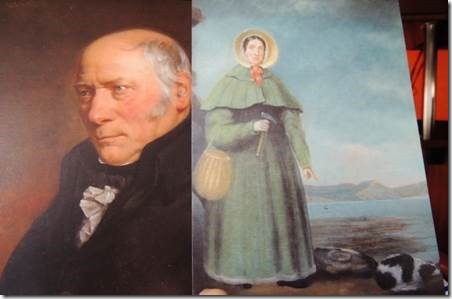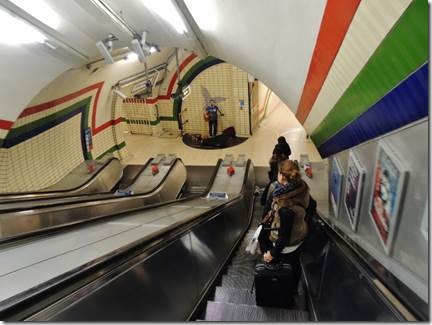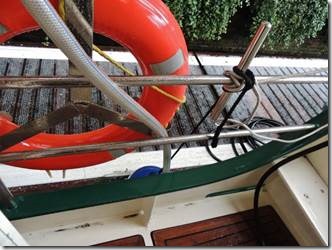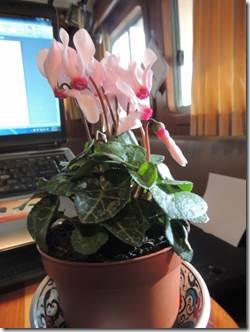Cheers,
I’m pooped! My nephew Andrew arrived on Friday and we’ve walked miles and miles since then. His interests are design, crafts, and architecture so we’ve looked at London a bit differently than we normally do. Just now Andrew and Randal are riding the London EYE. I’m here relaxing finishing this email I started days ago. Out “to do while Andrew is here” list is still pretty long, but that’s much better than “too short.” Thankfully the weather has really been cooperating.
Ru
From my very knowledgeable Cousin Ernest…..“My favorite department store there was Fortnum and Mason. I never missed a visit when I was in town. I always bought a supply of their marvelous jams and jellies… especially the many varieties of Orange jams they had… and brought them back for Mom, who loved them! Take a peek into Fortnum and Mason if you get a chance.”
|
Meeting for coffee with our cruiser friends in Côte for coffee. They have the loveliest Ladies Loo with a view into the marina. Randal and I planned to walk to Piccadilly to visit Fortnum and Mason after coffee as the sun was shinning! |
|
The sun was hitting the buildings across the Thames making the sharp geometrical shape stand out. We walked along the Thames from Tower Bridge to Westminster Bridge. |
|
Then clouds and drizzle came, then sun, then drizzle, then sun, then drizzle as we came to this statue of Boadicea across from Parliament. http://www.bbc.co.uk/history/historic_figures/boudicca.shtml |
|
Good advice Although my pal Martha and I did bike through London back in the mid-1980s, I don’t think I’d do it now. |
|
Florence Nightingale and her Fortnum & Mason connection 1855 – Crimea Queen Victoria, beef tea and Florence Nightingale In 1854 the story of the Charge of the Light Brigade gripped the nation. The Crimean was the first war to be covered by on-the-spot reporters, so for once the home front was aware of the soldiers’ appalling conditions. The Queen took a personal interest, sending Fortnum’s an order "to dispatch without delay to Miss Nightingale in Scutari a huge consignment of concentrated beef tea" after the scandal of the hospitals had become known in England. Every ship that sailed for the Crimea carried cases labelled Fortnum & Mason. Many officers wrote begging us to leave it off to discourage pilferers – by now an epidemic, sparked by the sight of our name. http://www.fortnumandmason.com/c-360-1800s-fortnum-and-mason.aspx Also good advice! “Horse Guards is official ceremonial entrance to St James’s and Buckingham Palace and headquarters to the Household Cavalry Mounted Regiment who provide troops for The Queen’s Life Guard. A royal guard has been kept here since 1660 when the original Guard House of the old Palace of Whitehall was on this site. The Palace of Whitehall, the largest palace in Europe at that time, was destroyed by fire in 1698 and replaced by the present Horse Guards building in 1753.” http://www.walklondon.com/london-attractions/horse-guards.htm |
|
The delivery entrance was our first view of the store… and we were wet and tired… “Fortnum’s began in 1707, when royal footman William Fortnum set up shop in St James’s with his landlord, Hugh Mason. Since then Fortnum & Mason has been an intrinsic part of the nation’s history and has a fascinating story to tell. Fortnum, meet Mason In 1705 Hugh Mason had a small shop in St James’s Market and a spare room in his house. The Fortnum family had come to London from Oxford as high-class builders in the wake of the Great Fire, helping to establish the St James’s and Mayfair areas as the most fashionable in London. William climbed another rung by taking a post as footman in Queen Anne’s household – and the room at Mr Mason’s. The Royal Family’s insistence on having new candles every night meant a lot of half-used wax for an enterprising footman to sell on at a profit – so while the Queen’s wages paid the rent, William’s enlightened sideline melted down into enough to start a respectable business. The rest, as they say, is grocery.” http://www.fortnumandmason.com/ |
|
A grand entrance way. We browsed a bit; I used the lovely ladies loo, and then Randal was done. When pals Mary and Rick get here I’ll return with Mary and really look around. |
|
We wandered through the fresh foods area of meats and sea food. Cheaper to eat lobster and crab in New England than old London! “Located in New Bedford, MA, America’s largest commercial fishing port, our Fisherman’s Market is the first wholesale seafood market in the northeast. We supply the public with the highest quality and most competitively priced seafood available. It doesn’t get any fresher than this! “ http://www.fishmanmkt.com/prices.shtml LOBSTER SOFT SHELL LOBSTER $6.75 / lb. HARD SHELL LOBSTER OVER 2 lbs $10.95 / lb. FROZEN LOBSTER CK MEAT 2 LB pkgs $49.95 / ea. CRAB SNOW CRAB CLUSTERS $8.00 / lb. KING CRAB LEGS $22.00 / ea. BACKFIN LUMP CRAB MEAT $14.00 / ea. BLUE CRAB MEAT $10.00 / lb. Some Fortnum & Mason history…. 1773 – The Boston Tea Party Boston Tea Party inspires American Independence movement It is not on record who supplied the tea, but it was probably not us: we have never charged extortionate prices and none of our teas do at all well with salt water. Since Independence, though, our American cousins have been among our most loyal customers. http://www.fortnumandmason.com/c-359-1700s-fortnum-and-mason.aspx 1794 – The F&M Post Office The Fortnum & Mason Postal Service Until the General Post Office came into being, the business of sending and receiving mail was open to anyone – and Fortnum’s grasped the opportunity. It had letterboxes for paid and unpaid letters which were picked up six times a day (this was before stamps, and the recipient usually paid the tab). Soldiers and sailors, already among the company’s best customers, received a discount. The arrangement drew all sorts of traffic to the store to be tempted by the already magnificent window and interior displays. This arrangement lasted until 1839, when the GPO was founded – a year before the Penny Black with its bust of a youthful Victoria. http://www.fortnumandmason.com/c-359-1700s-fortnum-and-mason.aspx 1886 – Young Mr Heinz Mr Heinz brings Baked Beans to Piccadilly Since the middle of the century Fortnum & Mason had been the leader in tinned goods – and chief provider of information on how to open the tricky devils with a pocket-knife. This made us the obvious first stop for a young entrepreneur lugging five cases of samples from the USA. Recognising a future staple we took them all, introducing the mighty baked bean to Britain for the first time – one of the more prosaic entries in our ever-expanding list of historic gastronomic firsts. http://www.fortnumandmason.com/c-360-1800s-fortnum-and-mason.aspx More history on their website. Reading about Fortnum & Mason during the 2 World Wars, Depression and time of great Expeditions is quite interesting. |
|
Wrapping Fortnum & Mason Standing at the entrance of the Geological Society across the street and view from the Geological Society Library window. (I had no idea the façade we saw wasn’t a permanent part of the store until I read the following. Duh!!!) http://www.fortnumandmason.com/c-1367-rory-dobner-for-fortnums.aspx “The new “wrap” for the shop – giant artworks covering up much-needed maintenance works on our Piccadilly and Duke Street frontages – is designed by Rory Dobner.” “Rory, who was born in England and studied at the Chelsea School of Art & Design and Central St Martin’s, is influenced by classic English children’s illustrations such as E. H. Shepard’s Winnie the Pooh and Peggy Fortnum’s Paddington Bear. He drew on another children’s favourite, Alice in Wonderland, for this highly collectable new range of teaware. He was also inspired by the idea of tea parties of the past: “Everyone remembers their grandmother laying the table with sweets and cakes and cut-up sandwiches,” * he says. “I want to encourage people to set up tables [for tea] again, we’re all in such a rush these days [but] I think people are doing that more and more.” “This attention to detail is even more important when one’s designs are blown up to the size of a six-storey building on one of London’s busiest thoroughfares. Rory wanted his illustration to be “peaceful”, rather like “a breeze going past, capturing a moment” as butterflies carry banners and his famous smoking goldfish and monocled cat peer out of windows at passers-by. ‘I used to go to department stores as a child, I loved the amazing displays. I never imagined I would be part of one,’ he marvels.” http://www.fortnumandmason.com/c-1367-rory-dobner-for-fortnums.aspx * When I turned some “young adult” age, or maybe even a bit older, my mom made a tea party for some of my girlfriends. We had apricot nectar lemon pound cake on special china plates and drank from cut glass goblets. And we sat in the dining room rather than at the kitchen table. We were all impressed! http://golondon.about.com/ link to see the famous clock we missed because of the maintenance work. |
|
The Geological Society and “the map that changed the world.” The Geological Society of London was founded in 1807. It is the UK national society for geoscience, and the oldest geological society in the world. https://www.geolsoc.org.uk/about Library and Information Services Welcome to one of the finest Earth Science libraries in the world. The Library contains over 300,000 volumes of books and serials and 40,000 maps, making it a collection of national importance covering all aspects of the geological sciences. We currently subscribe to over 600 journal titles from around the world. The Library’s dedicated staff are available to assist you with all your information needs. https://www.geolsoc.org.uk/library http://blog.geolsoc.org..uk/ is a really interesting article about the chandeliers hanging in the library. I thought they were lovely but I do know in a library setting “lovely doesn’t always = functional.” And as it was professional courtesy that allowed me to take any photos at all, I only took this one. |
|
A favorite book of Randal’s so he really wanted to visit “the map.” Simon Winchester’s book about William Smith’s map and a post card of the “map that changed the world.” Photos of the map weren’t allowed due to copyright. |
|
William Smith LLD 1769 -1839 Mary Anning 1799 – 1846 souvenir postcards “To emphasize what Smith considered his greatest achievement–he was the first to discover that the strata of England were in a definite order and the first to show that their fossil contents were in the same order–he published an ordered column of colored tablets that he referred to as a geological column of organic (organized) fossils in 1816 while copies of the map were still printing. (see Contents, Part III). For all its complexity the map itself was incomplete without the concomitant ordering of the fossils. Smith was probably the first to understand that both the strata and their fossil contents were in such a natural order and that it was an order of indefinitely wide extension, i.e. from local quarries to the whole of England and beyond. “ http://www.unh.edu/esci/WilliamSmiths-StrataIdentified/i/explanatory.html This University of New Hampshire site was recommended by the Geological Society. I was more intrigued by Mary Anning. Wish I’d paid more attention during my year of geology at U Mass. “Mary Anning was born on 21 May 1799 in Lyme Regis. Her parents Richard Anning (c.1766-1810), a cabinet-maker and carpenter, and mother Mary had at least ten children, with only two surviving to adulthood – Mary Anning and her brother Joseph (1796-1849). Her father Richard was known locally as a fossil collector, selling his finds to tourists who flocked to the seaside resort at the end of the 18th century. However his death in November 1810 left his family with £120 of debts and having to rely on relief given by the Overseers of the Parish Poor. Both Joseph and Mary had been tutored by their father in how to collect fossils. Their first major find, an Ichthyosaur, was discovered by her and her brother in two sections in 1811 and 1812. Other examples of this fossil ‘crocodile’ had been found before, but this was the first to come to the attention of gentlemen scientists in London one of whom, Everard Home, described it in a paper read before the Royal Society in 1814. It was to make her name. Mary’s second major discovery was of a nine feet long animal, with a small head like a turtle but very long neck. It was described at the Geological Society’s meeting of 20 February 1824 and was recognised by William Daniel Conybeare as being a virtually complete example of a Plesiosaurus. The find not only established the Anning family credentials as fossil dealers, but Mary became a draw in her own right. Tourists came to Lyme to not only buy fossils but to see her. Lady Harriet Silvester (1753-1843) visited Mary on 17 September 1824 and noted in her diary: “the extraordinary thing in this young woman is that she has made herself so thoroughly acquainted with the science that the moment she finds any bones she knows to what tribe they belong. She fixes the bones on a frame with cement and then makes drawings and has them engraved…It is certainly a wonderful instance of divine favour – that this poor, ignorant girl should be so blessed, for by reading and application she has arrived to that degree of knowledge as to be in the habit of writing and talking with professors and other clever men on the subject, and they all acknowledge that she understands more of the science than anyone else in this kingdom.” Other discoveries were to follow, such as the ink bags from fossilised squids which could then be ground down to be made in fossil ink. ‘Coprolites’, that is fossil faeces were identified by Mary as early as 1824 and in 1828 saw her third major find, that of a fossil flying reptile [Pterodactylus]. In December 1829 she discovered the fossil fish Squaloraja, seen as the intermediary between sharks and rays and in 1830 her last important find, that of the Plesiosaurus macrocephalus (named by William Buckland in 1836). By the 1840s, her large fossil finds (and the income they derived) had all but dried up. However, in recognition of her achievements, she received three different annuities and subscriptions raised by the scientific community in the last decade of her life. She died at the age of 47 years of breast cancer.” |
|
Going home on the Picadilly line : entertainers are fairly common in the tube stations. |
|
One “final” cold snap where we had sleet on the pontoon and my cyclamen because it really seems like spring. The cyclamen were my favorite wild flowers in North Cyprus. |

